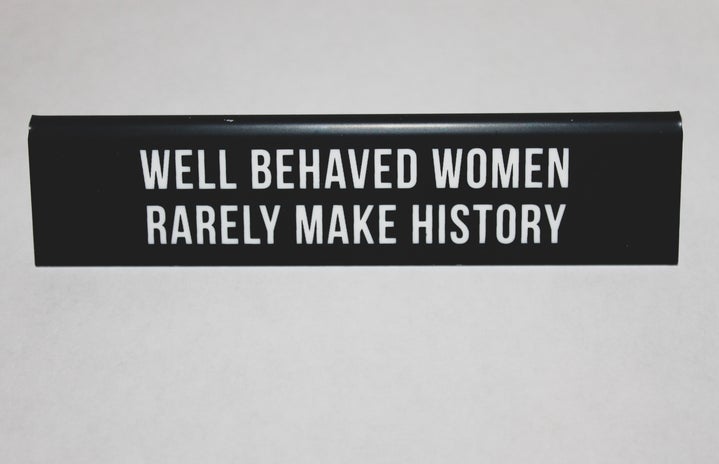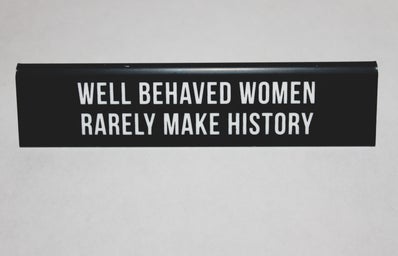To finish off another Women’s History Month (to be honest though, we all know every month is Women’s History Month, but that’s a whole other story…) I thought it would be a good time to address a conflict of interest regarding our favorite magical, singing, animated ladies: the Disney Princesses. Pretty much everyone grew up with these spirited characters and they were an important part of most of our childhoods; I’m not ashamed to admit that at twenty years old I still get in heated arguments with my friends about which princess is the best. Beyond the soundtracks, the costumes, the demeanors, the magical creature friends and the various other factors that create the Disney Princesses mold, there’s a larger underlying issue that arises when you consider what Disney Princesses stand for and how they influence the perception of women in society. This lends itself to a very important question; are Disney Princesses still relevant in our modern world of respected feminist ideologies?
The Disney Princesses have always been popular since Snow White was introduced way back in the late 1930s and have continued to enchant the lives of people everywhere through their films, merchandise, and character performers around the world. While this steady popularity has been relatively consistent throughout the years, the 2015 craze of “reimagined” princesses ignited a new interest that simultaneously supported and questioned the role Disney Princess play in lives of people, especially young girls. As I’m sure we all remember, the highest trending reimaginings showed the princesses with different ethnicities, with average waistlines, in glasses, with no makeup, and being historically accurate, not to mention the various other trends like the princesses as Minions, as hot dogs, and unfortunately but inevitably, as Donald Trump.
So what did these creative changes do? Well first off, they put the princess in a new light, making them more accurate and representative of real women. In a generation of movements, self-love, body positivity, and a new wave of feminism (s/o to Emma Watson) just to name a few, it’s no surprise that these reimaginings gained so much popularity. On top of the images themselves, the reimaginings also sparked a conversation about whether or not the Disney Princesses send the right message to and about women in society.
The Disney princess represent an ideal; they are all beautiful, they all find love, and ultimately, they are all saved by their handsome, hunky princes in order to live that clichéd happily ever after. With social media booming with support for strong women who are confident, independent, and come in all different shapes and sizes, it makes sense why some people question if the Disney Princesses are a little past their prime; they simply don’t represent the modern woman, or the women we are teaching young girls to be anymore.
I definitely think there is some validity in this expiration date on how women are portrayed in classic fairytales, but at the same time they are just that: fairytales, stories, make believe. These stories are hundreds of years old and therefore represent ideals of the time they were imagined. Way back when, the role of a woman was to be beautiful and passive to her brave, strong male counterpart. This isn’t an ideology limited to the imagination of storytellers, women’s history has been a bumpy road and is a road we are still traveling on today despite all the progress that has been made so far. Why should we judge these fairytale adaptations as being a bad influence or representation of women? We don’t pretend that we could always vote in this country. A group of strong willed women fought to make that possible and we are proud of that; we don’t view the women beforehand as any less because we understand that the balance of power between men and women was totally different back then.
Sure the traditional princesses were passive and let the men save them, but look at the strides Disney has made with Mulan, Tangled, Frozen and Brave. These films emphasize the importance of family, of women making their own choices, and the love interests are just an added bonus to the plotline. These modern princesses are in line with current values by showcasing how the woman is in control of her destiny, but that doesn’t necessarily mean lessons traditional princesses teach aren’t any less important.
Sure Cinderella got her literal “princess moment” with the ball gown and the magic and because of Prince Charming’s persistent searching (he’d definitely be a good Hufflepuff, right?), but that’s not actually that important overall. Cinderella was eventually able to become a princess because she dreamed and believed there was something more to her life than what people perceived. She took chance and went to that ball and slayed the night. Sure there was a little magic and a little love, but she ultimately made the choice to take that chance, get in that pumpkin carriage, and go to the ball despite being told that she shouldn’t. The traditional princesses dream and believe in something just like the modern princesses. They value and demonstrate friendship and kindness. They have loving hearts and kind spirits; these all qualities that people, no matter what age, should learn and practice.
Plus, don’t we all feel like Cinderella sometimes? Stuck in a fixed routine, forced to clean the proverbial floors and chimneys of our lives? Taking that 100 level course that you absolutely hate, working that awful part time job, all for what? You take that dumb course so you have the pre rec to take classes you’re actually interested in; you work that job so you can pay for an education so that you can have a career you are passionate about. So there may not be a sparkly gown (but no one said there couldn’t be!), but by dreaming and believing, being kind and genuine, and being in control of your own destiny like traditional and modern princesses alike, you’ll end up where you want to be; that’s a real life princess moment, and that’s why the Disney Princesses will always be relevant.


